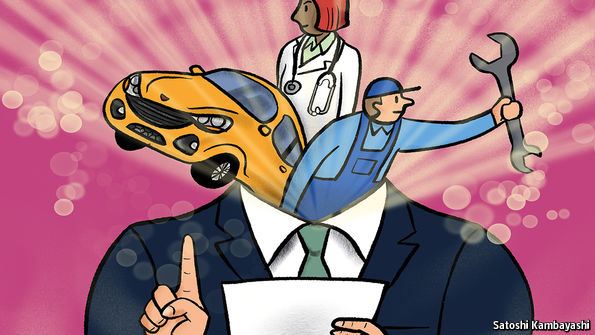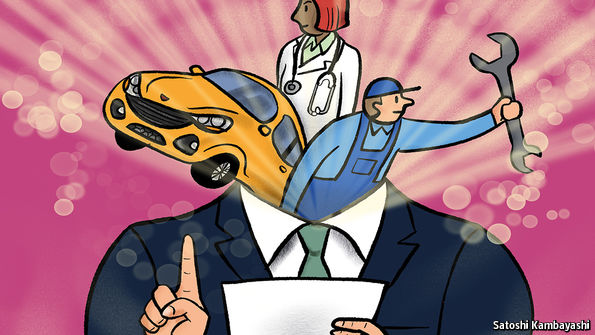2017年3月29日
「インステック」―保険業界の破壊者、ディスラプター
保険会社はすでにサービス提供者からコンサルタントへ職業替えをしている
おはようございます。
以前、二回に分けて「フィナンシャル・タイムズ」の記事による保険業の「フィンテック」である「インステック」の現状をお伝えしましたが、今回は「ザ・エコノミスト」の記事によるその続編です。
「フィンテック」というビジネスモデルが、金融業を破壊(ディスラプション、分解、崩壊)していくことから、他業種、特に保険業界で同じことを起こし始めているという現状があります。巨大な顧客層の構築と長期金利に依存した「楽な商売」システムに依存しすぎた保険業界は、新たなビジネスモデルを拒否し、あくまで「人力」と「手作業」にこだわってきました。同じ金融業である銀行業でも、ATM設置など、電子取引のイノベーションは数十年前から取り組み続けてきたことに比して、旧態依然の業界でした。
さらに、リーマンショックのような未曽有の金融危機も、政府による手厚い補償のおかげでほぼ無傷で乗り越えてきたということも、業界の体質を表しています。
しかし、大災害による支払いという最悪のシナリオや価格比較の慣行、数値演算処理(number-crunching、クランチ=データの高速処理という意味で使われます)アルゴリズム等の登場で、これまでのビジネスモデルでは収益性の悪化が進みつつある現状が業界に広がっています。
この「インステック」は「フィンテック」(同じ金融業界)と「ヘルステック」(同じヘルス業界)の間にある橋渡しの役割を果たしています。価値基準支払という新しい医療報酬体系の構築が進みつつあるなかで、医療業界と保険業界はこの点で利益を共有しています。
「インステック」はアメリカのみならず日本においても急速に進みつつあるビジネスです。医療業界にあるものとしては、これを次の時代の医療サービスモデルのひな型として注目していくべきだと思います。
保護の代理人
来るべき保険革命 技術革新と競争は自己満足産業を破壊する
Counsel of protection
The coming revolution in insurance
Technological change and competition disrupt a complacent industry

Mar 9th 2017
The Economist
激しく絶え間なく変化する世界的な金融の世界では、保険は比較的緩やかに停滞したままでした。2008年に納税者から救済されたアメリカの保険会社AIGの例外を除いて、保険業界は金融危機をほとんど無傷で乗り切りました。しかし現在、保険会社は技術革新のために前例のない競争圧力に直面しています。この圧力は、適応だけでなく変化を求めています。
保険にとって欠かすことのできない製品は、不測の事態に直面した時に、普通はお金という形で安心を保障することですが、明白な代替品がほとんどありません。結果としては、保険会社は巨大な顧客基盤を築いてきました。投資収益は、利益の増加を当てにできるようになりました。このような楽な生活のため、保険業界は近代化することを無頓着に拒否するようになりました。保険業界は依然として人間の労働に驚くほど依存しています。保険会社はデータは見ますが、多くの会社はリスク評価と保険料設定を、依然として人間の判断に依存しています。保険料請求は手作業で見直されることが多いのです。
オートメーションと技術の進歩は、新しい参入者にとってはチャンスです。新しい保険会社を一から十まで最初から始めることはまれですが、多くの企業が保険業務の一部に狙いを定めています。例えば、米国の「金融分析」ヘッジファンド大手であるTwo Sigmaは、リスクの評価と保険料の設定を人間よりも正確で速くできる大量の数値演算処理アルゴリズムに賭けています。 他の新興企業は代替販売ルートを開拓。たとえば、ドイツ企業Simplesuranceは、製品保証保険を電子商取引サイトに統合しています。
保険会社は、さまざまな方法で技術的な混乱に対応しています。Two Sigmaは、バミューダの保険会社であるハミルトンと、(現在は米国の中小企業保険のみに適用されている)保険証券を実際に発行しているAIGとのジョイントベンチャーに優れた分析能力を提供しています。ドイツの保険会社AllianzはSimplesuranceの株を買収しただけです。つまり、多くの保険会社は、この目的のために、社内ベンチャーキャピタル部門を有しているのです。3番目のアプローチは、イギリスの保険会社Avivaがロンドンのおしゃれ地区であるHoxtonに「デジタルガレージ」を建設することで行ったような、社内刷新を促進することです。
現職者が直面している最大の脅威は、最終的な収益への脅威です。生命保険会社は、保証された保険金支払いを満たすために投資利益率に依存しており、長期にわたる金利の低迷に苦しめられています。厳しい環境のため、リスクをより多く投資家に負担させる製品へ生命保険の移行が加速しています。例えば、英国の企業Standard Lifeはほとんどの企業よりも早く移行し、主に資産管理を長く行っています(記事参照)。
その一方で、車や家を守る保険プランなどの損害保険(P&C)の提供者は、自社の価格決定力が、特に価格比較のウェブサイトからの絶え間のない圧力を受けています。古いシステム維持の依然として高いコストと相まって、これは収益性が着実に悪化していることを意味しています。 たとえば、アメリカのP&C業界では、保険金請求と費用を保険料収益の割合として表す「複合比率」が、2013年の96.2%から2015年には97.8%に、2016年には100.3% (すなわち、正味引受損失)にじわじわと着実に上昇しています。コンサルタント会社であるBain&CompanyのHenrik Naujoksは、このような保険会社は、低コストのサービス提供者になるか、提供するサービスを通じて差別化するかという厳しい選択に直面していると述べています。
特有のサービスを提供する非常に簡単な方法の1つは、既存のデータを新しい方法で使用することです。 保険会社は、例えば自然災害から被る損失を見積もるために、長い間、最悪のシナリオを描いてきました。しかし、そのような出来事に備えるために顧客や地方自治体と協力して取り組み始めている企業も存在します。彼らは事実上、リスク予防コンサルタントになりつつあるのです。フランスの保険会社AXAは最近、セーヌ川氾濫モデルを使用して緊急時対応保険を準備しています。AXAのP&C部のGaëlleOlivierは、この保険は2016年6月の洪水に対応し、被害を軽減するのに役立つことを実証したと述べています。
被害対策
技術に精通した保険会社は、まったく新しいデータソースを利用してさらに一歩進みつつあります。ボイラーの温度から健康データ、運転スタイルまでのすべてを追跡するためにセンサーを使用しており、それに応じて較正された価格決定と補償範囲で保険プランを提供しています。センサーから得られるデータも、新しい種類のリスク予防サービスの提供を可能にします。Avivaと英国のホームサービス会社であるHomeServeとの提携の一環として、保険会社は顧客の入水管に微量の漏れを検出することのできるセンサ(「LeakBot」)を無料で設置し、HomeServeが、パイプが家を水浸しにし、深刻な被害をもたらす前に修復します。
より多くのサービスを提供する方向へのシフトは、価格を超えた要因で競争を促進しています。ブラジルの保険会社Porto Segurosは、牽引車サービスから診察予約まで、さまざまなサービスを提供します。フランスでは、長距離ライドシェアリングアプリであるBlaBlaCarのユーザーにAXAが補償を提供しています。この保険の主な目的は、顧客がまだ目的地に到達可能なことを保証するものです。例えば、車が故障した場合、路上自動車修理から代替輸送(例えば、タクシーを呼ぶなど)に至るまでの様々なサービスを提供します。
しかし、保険会社がサービス提供者とリスクコンサルタントになるためには、多くのハードルに直面します。Avivaの損害保険総責任者であるMaurice Tullochは、このようなサービスはまだほとんどの顧客に受け入れられていないことを認めています。 これまでのところ、彼の会社は同業者同様に、顧客から直接お金を稼ぐのではなく、保険料を削減することによって顧客を新しい提供商品に呼び込んで加入させることに力を注いできました。Avivaは、例えばHomeServeのセンサーと修理のコストを保険金請求額の減少から埋め合わせられると考えています。
将来の可能性の一つの例は、自動車産業です。自動車メーカーは、製造上の欠陥を補償するために昔から製造物責任保険に加入してきました。しかし、ボルボとメルセデスは自社の自動運転車に自信を持っているので、保険に加入するつもりは全くないことを昨年発表しました。 彼らは "自己保証"するのです、つまり、事故から直接受けた損害をすべて負担するようになります。 そのような傾向が保険の存在そのものを脅かすと考える人もいます たとえそうでなくても、Bain社のNaujoks氏は、今後の5年間で過去20年間よりも大きな変化が保険業界にもたらされることをただ待ち望んでいるだけではないのです。
以下は英語原文です。
Counsel of protection
The coming revolution in insurance
Technological change and competition disrupt a complacent industry

Mar 9th 2017
IN THE stormy and ever-changing world of global finance, insurance has remained a relatively
placid backwater. With the notable exception of AIG, an American insurer bailed out by the taxpayer
in 2008, the industry rode out the financial crisis largely unscathed. Now, however, insurers face
unprecedented competitive pressure owing to technological change. This pressure is demanding not
just adaptation, but transformation.
The essential product of insurance—protection, usually in the form of money, when things go
wrong—has few obvious substitutes. Insurers have built huge customer bases as a result. Investment
revenue has provided a reliable boost to profits. This easy life led to a complacent refusal to
modernise. The industry is still astonishingly reliant on human labour. Underwriters look at data but
plenty still rely on human judgment to evaluate risks and set premiums. Claims are often reviewed
manually.
The march of automation and technology is an opportunity for new entrants. Although starting a new
soup-to-nuts insurer from scratch is rare (see article), many companies are taking aim at parts of the
insurance process. Two Sigma, a large American “quant” hedge fund, for example, is betting its
number-crunching algorithms can gauge risks and set prices for insurance better and faster than any
human could. Other upstarts have developed alternative sales channels. Simplesurance, a German
firm, for example, has integrated product-warranty insurance into e-commerce sites.
Insurers are responding to technological disruption in a variety of ways. Two Sigma contributes its
analytical prowess to a joint venture with Hamilton, a Bermudian insurer, and AIG, which actually
issues the policies (currently only for small-business insurance in America). Allianz, a German
insurer, simply bought into Simplesurance; many insurers have internal venture-capital arms for this
purpose. A third approach is to try to foster internal innovation, as Aviva, a British insurer, has done
by building a “digital garage” in Hoxton, a trendy part of London.
The biggest threat that incumbents face is to their bottom line. Life insurers, reliant on investment
returns to meet guaranteed payouts, have been stung by a prolonged period of low interest rates. The
tough environment has accelerated a shift in life insurance towards products that pass more of the
risk to investors. Standard Life, a British firm, made the transition earlier than most, for example,
and has long been primarily an asset manager (see article).
Meanwhile, providers of property-and-casualty (P&C) insurance, such as policies to protect cars or
homes, have seen their pricing power come under relentless pressure, notably from price-comparison
websites. In combination with the stubbornly high costs of maintaining their old systems, this has
meant that profitability has steadily deteriorated. The American P&C industry, for instance, has seen
its “combined ratio”, which expresses claims and costs as a percentage of premium revenue, steadily
creep up from 96.2% in 2013 to 97.8% in 2015, and to an estimated 100.3% for 2016 (ie, a net
underwriting loss). Henrik Naujoks of Bain & Company, a consultancy, says this has left such
insurers facing a stark choice: become low-cost providers, or differentiate themselves through the
services they provide.
One fairly simple way to offer distinctive services is to use existing data in new ways. Insurers have
long drawn up worst-case scenarios to estimate the losses they would incur from, say, a natural
catastrophe. But some have started working with clients and local authorities on preparing for such
events; they are becoming, in effect, risk-prevention consultants. AXA, a French insurer, has recently
started using its models on the flooding of the Seine to prepare contingency plans. Gaëlle Olivier of
AXA’s P&C unit says the plans proved helpful in responding to floods in June 2016, reducing the
damage.
Damage control
Tech-savvy insurers are going one step further, exploiting entirely new sources of data. Some are
using sensors to track everything from boiler temperatures to health data to driving styles, and then
offering policies with pricing and coverage calibrated accordingly. Data from sensors also open the
door to offering new kinds of risk-prevention services. As part of Aviva’s partnership with
HomeServe, a British home-services company, the insurer pays to have a sensor (“LeakBot”)
installed on its customers’ incoming water pipes that can detect even minuscule leaks. HomeServe
can then repair these before a pipe floods a home, causing serious damage.
The shift towards providing more services fosters competition on factors beyond price. Porto
Seguros, a Brazilian insurer, offers services ranging from roadside assistance to scheduling doctor’s
appointments. In France AXA provides coverage for users of BlaBlaCar, a long-distance ride-sharing
app. The main aim of the policy is to guarantee that customers can still reach their destination. If, say,
the car breaks down, it offers services ranging from roadside car-repair to alternative transport (eg,
calling a taxi).
Insurers face many hurdles, however, to becoming service providers and risk consultants. Maurice
Tulloch, head of the general-insurance arm of Aviva, admits that such services are yet to catch on
with most customers. So far, his firm, like its peers, has focused on enticing them to adopt the new
offerings by cutting insurance premiums, rather than on making money directly from them. It
reckons it can recoup the cost of, say, the HomeServe sensors and repairs from the reduction in
claims.
One example of what the future may hold comes from the car industry. Carmakers have traditionally
bought product-liability insurance to cover manufacturing defects. But Volvo and Mercedes are so
confident of their self-driving cars that last year they said they will not buy insurance at all. They
will “self-insure”—ie, directly bear any losses from crashes.
Some think that such trends threaten the very existence of insurance. Even if they do not, Bain’s Mr
Naujoks is not alone in expecting the next five years to bring more change to the insurance industry
than he has seen in the past 20.